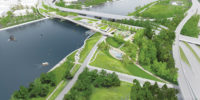A Paean to public architecture and the buildings and places that bring us together, Eric Klinenberg’s Palaces for the People shows how modest undertakings and subtle, insightful design can strengthen communities. The book makes the connection between the much decried decline of civic life and the spaces that help us support each other—especially in neighborhoods where social connections have been severed by population decline, joblessness, abandonment, and disinvestment.
In Palaces for the People, Klinenberg, a sociologist and director of New York University’s Institute for Public Knowledge, builds upon his 2002 book, Heat Wave. That work reported social isolation and neighborhood breakdown as key reasons so many people died in Chicago during one torrid week in the summer of 1995. He found many fewer deaths in areas with strong communal ties forged by shared gathering places.
Klinenberg calls settings that boost communities and foster mutual assistance networks “social infrastructure.” His new book devotes considerable attention to libraries, which have reinvented themselves with services such as computer training and job-preparedness programs. Public events at libraries bring the isolated into contact with others and bring together diverse communities. Teens with tumultuous home lives find a place of refuge to study and hang out with friends.
Subtleties are important. Klinenberg describes a spot in front of his own children’s school that has turned into a natural meeting place for parents. Playgrounds are social condensers, of course, but spaces that invite multiple generations, like community gardens, are better.
The book makes the case that social infrastructure combats crime by providing alternatives to idleness. Klinenberg also argues that it can help alleviate distrust of law enforcement, highlighting Bjarke Ingels Group’s design for New York’s 40th Precinct. It has a glass-fronted community room to reduce tensions between residents and the police.
Social infrastructure can be destroyed by disasters—or rebuilt by such events, as happened in New Orleans after Hurricane Katrina, when strong bonds established over decades to survive poverty aided community rebuilding and drew a vast diaspora of former residents back to help. Now several cities are fitting out public buildings to survive calamities and serve as emergency shelter and recovery-coordination centers.
Klinenberg was the research director of Rebuild by Design, the Obama Administration design competition initiated following Hurricane Sandy. It generated shoreline-protection and community-enhancing schemes, such as the project by landscape architect SCAPE for New York’s Staten Island. It will include beach pavilions for community meetings and education that will engage people in safeguarding their environment.
The book’s observations echo those of a research team I led over three years at the New York City Department of Design and Construction. Our work found other building types that could enhance social infrastructure—neighborhood health facilities, for example, or networked police stations, courts, probation offices, and social-services centers. Such coordination can improve outcomes for the incarcerated.
Palaces for the People shows that a little social infrastructure could be really big.
Take a look inside Palaces for the People below, courtesy of Penguin Random House.






Post a comment to this article
Report Abusive Comment